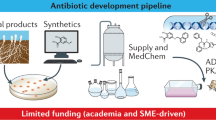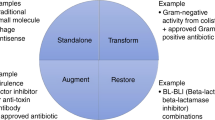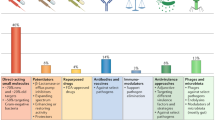Abstract
The path from antibiotic compound discovery to the market is marked by many potholes and its negotiation is often dependent on luck and persistence. Perhaps the prime example of this is the case of the development of tiacumicin B to Fidaxomicin, where both parameters were critical and the path was particularly circuitous.
Similar content being viewed by others
Main
The late Les Freiberg, one of the best and most underappreciated medicinal chemists I have known in almost 50 years of drug discovery, once told me that a medicinal chemist can work hard and intelligently all his/her life and never get a drug on the market. The tortured road in the discovery and development of Fidaxomicin may shed some light on the obstacles that underline this truism.
In the 1980s, the mantra for the discovery of new antibiotics was that the best chance of finding a novel structure was to find a hitherto unknown microbe as the potential producer. In our natural product discovery project at Abbott Laboratories, Jim Karwowski headed the microbe isolation group. From a soil sample collected in Hamden, CT, his team isolated a novel subspecies of Dactylosporangium aurantiacum, which, when grown in one of our primary screening media, yielded activity against MRSA. This activity led to the scale-up fermentation and isolation, by Jill Hochlowski, of a family of 18-membered macrolides, which we named the tiacumicins. Initially, only the first three, tiacumicin A, B and C, were isolated, but as we believed these to be novel at the time Jim and Marianna Jackson embarked on a yield improvement program, Jim undertaking strain improvement and Marianna the fermentation optimization. They soon had yields that encouraged us to take the fermentation to the pilot plant, where initially 4500 l were harvested, and the crude product was given to Jill, who isolated multigram quantities of tiacumicins B and C and much smaller amounts of three new related congeners, D, E and F. Although tiacumicin A was inactive in our screens, it was very helpful in the structure elucidation of the series as it was a simple monoglycoside. We filed a United States provisional patent application on 26 September 1986 and, under Abbott’s very liberal publication policy, were able to present microbiology and structures at the ICAAC meeting in New Orleans, LA, a few days later.
In July of that year, Satoshi Ōmura’s group submitted two manuscripts to the Journal of Antibiotics (JA) describing the discovery, structures, activity and producing organism (a subspecies of Micromonospora echinospora) of a family of antibiotics named the clostomicins.1, 2 These papers were published in the November issue of JA, which we received shortly after submitting our manuscripts to JA, and which came out in May 1987. The clostomicin papers made us aware of two critical things. Our original in vitro data,3 indicating a lack of activity of the tiacumicins against Clostridium difficile, must have been wrong. Accordingly, retesting revealed that tiacumicins B, C and F had very strong activity against this pathogen as well as against Clostridium perfringens.4 Moreover, the papers made us aware of the lipiarmycins, a third family discovered more than 10 years earlier, by the team at Gruppo Lepetit, from a new Actinoplanes species.5 That we had not been aware of this discovery is reprehensible, and although no complete structure had been published, the structure of a methanolysis product, methyl 2-O-methyl-4-O-homodichloroorsellinate-β-rhamnoside, revealing a substructure common to the active members of all three families, was known since 1983.6 These findings required that we notify the United States Patent and Trademark Office of the prior publications. Fortunately, the Lepetit patent claimed lipiarmycin only as a compound having certain physical characteristics, and the 1H NMR spectrum made it quite evident that the ‘compound’ was very impure. This allowed us to change the claim for tiacumicin B to ‘a substantially pure compound of the formula….’, and the US patent 4918174 was then issued on 17 April 1990. Subsequently, a paper describing the structures of the lipiarmycins A3 and A47 confirmed that the original preparation was a 3:1 mixture of A3 and A4. This paper was published almost coincidently with our paper describing the structures of the tiacumicins.8 The structures of all known members of these 18-membered macrolides are presented in Figure 1. It should be noted that the absolute stereochemistry is only known for tiacumicin B, and, given the Celmer model for the stereochemistry of macrolides,9 it has been assumed that this will be the same throughout the macrolide ring, except that no such assumption applied for the exocyclic position C-18. Given this assumption, it would appear that lipiarmycin A3, clostomicin B1 and tiacumicin B were identical and among the most active against C. difficile. Tiacumicin B was also the most abundant species in our tiacumicin complex.
In the hamster model,4 which was later improved by Jeff Alder to develop an impressive data package, all vancomycin-treated animals died shortly after treatment ceased, whereas tiacumicin B-treated animals survived without apparent development of colitis. Recurrence of the infection is a major drawback of vancomycin treatment of colitis, and, on the basis of our results, Jake Clement delivered a presentation to Abbott management proposing Tiacumicin B as a product candidate. The marketing projections killed the project within Abbott, and it was outlicensed to Pathogenesis, where the development was championed by a former Abbott employee, Bill Baker. When Pathogenesis was acquired by Chiron in August 2000, Bill negotiated yet another outlicensing of tiacumicin B to Optimer Pharmaceuticals and worked with them for some time on the continued development. The manufacturing and purification was overseen by yet another ex-Abbott employee, Youe-Kong Shue. Neither Bill nor Youe-Kong had worked on anti-infectives at Abbott.
Optimer took tiacumicin B through the clinic and, after US FDA approval on 27 May 2011, to market as Dificid. In October 2014 Cubist acquired Optimer, and then Cubist, in turn, was acquired by Merck in January 2015. It is hard to imagine a more checkered development history than that of tiacumicin B, nor one that was so dependent on coincidence. Although tiacumicins were discovered for their activity against MRSA, the relative potency, and the pharmacokinetics of tiacumicin B in animals, directed its development toward the treatment of C. difficile-induced colitis. Fidaxomicin is definitely the best drug currently on the market for the treatment of colitis caused by C. difficile, the third most common nosocomial infection in the United States, and one that the Centers for Disease Control and Prevention estimates causes 29,000 deaths per year in the US, currently. The drug is not absorbed after oral administration, and as of June 2016 no clinical resistance has been reported. The recurrence rate after treatment is definitely less than that following vancomycin treatment, although not as low as might have been hoped for, from the hamster experiments. This is probably a question of the ratio of recurrence caused by spore survival to that caused by reinfection. Tiacumicin B would never have been developed had Lepetit pursued the lipiarmycins diligently, nor if Professor Ōmura had not discovered the clostomicins. The road from discovery to the market is highly adventurous and can indeed be very bumpy.
References
Ōmura, S. et al. Clostomicins, new antibiotics produced by Micromonospora echinospora subsp. armenica subsp. Nov. I Production, isolation and physico-chemical and biological properties. J. Antibiot. 39, 1407–1412 (1986).
Takahashi, Y., Iwai, Y. & Ōmura, S. Clostomicins, new antibiotics produced by Micromonospora echinospora subsp. armenica subsp. Nov. II Taxonomic study of the producing organism. J. Antibiot. 39, 1413–1418 (1986).
Theriault, R. J. et al. Tiacumicins, a novel complex of 18-membered macrolide antibiotics. I Taxonomy, fermentation and antibacterial activity. J. Antibiot. 40, 567–574 (1987).
Swanson, R. N. et al. In vitro and in vivo evaluation of tiacumicins B and C against Clostridium difficile. Antimicrob. Agents Chemother 35, 1108–1111 (1991).
Coronelli, C., Parenti, F., White, R. & Pagani, H. (Gruppo Lepetit S.p.A) Lipiarmycin and its preparation. US3978211 (1976).
Martinelli, E., Fantuolo, L., Tuan, G., Gallo, G. G. & Cavalleri, B. Structural studies on lipiarmycin. I. Characterization by 1H and 13C NMR spectroscopy and isolation of methyl 2-O-methyl-4-O-homodichloroorsellinate-β-rhamnoside. J. Antibiot. 36, 1312–1322 (1983).
Arnone, A., Nasini, G. & Cavalleri, B. Structure elucidation of the macrocyclic antibiotic lipiarmycin. J. Chem Soc. Perkin Trans. I 1987, 1353–1359 (1987).
Hochlowski, J. E. et al. Tiacumicins A novel complex of 18-membered macrolides. II. Isolation and structure determination. J. Antibiot. 40, 578–588 (1987).
Celmer, W. D. Macrolide stereochemistry. 3. A configurational model for macrolide antibiotics. J. Am. Chem. Soc. 87, 1801–1802 (1965).
Author information
Authors and Affiliations
Corresponding author
Ethics declarations
Competing interests
The author declares no conflict of interest.
Additional information
Dedicated to our Editor-in-Chief Emeritus and Nobel Laureate, Professor Satoshi Ōmura, with the highest personal and professional respect.
Rights and permissions
About this article
Cite this article
McAlpine, J. The ups and downs of drug discovery: the early history of Fidaxomicin. J Antibiot 70, 492–494 (2017). https://doi.org/10.1038/ja.2016.157
Received:
Revised:
Accepted:
Published:
Issue Date:
DOI: https://doi.org/10.1038/ja.2016.157
This article is cited by
-
Novel fidaxomicin antibiotics through site-selective catalysis
Communications Chemistry (2021)




